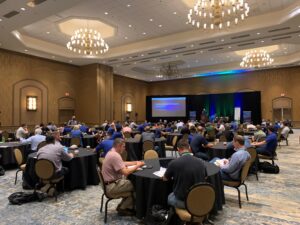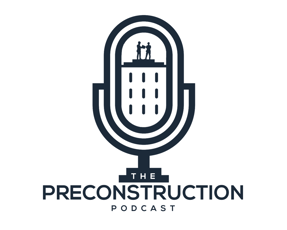Discussing Preconstruction Advancement at Advancing Preconstruction
One of our favorite industry experiences is, without a doubt, the Advancing Preconstruction conference. There’s a lot of reasons for that: it’s typically held in Dallas, our home base; we get to host post-conference events and show both clients and prospects around our thirtieth-floor office; and, most importantly, we get to introduce people to our revolutionary construction estimating software, DESTINI Estimator.
What does that look like, you might ask? As one of the vendors that attend Advancing Preconstruction, we do set up a booth in the vendor hall to facilitate conversations for those who might want to buy our construction estimating software. We also host a workshop to kick off the conference. While many vendors often choose to use this time to demo their product, we believe that it’s far more beneficial to share preconstruction resources that all listeners can find useful, whether or not they intend to buy our construction estimating software.
 We discussed the Preconstruction Data Lifecycle at our Advancing Preconstruction workshop.
We discussed the Preconstruction Data Lifecycle at our Advancing Preconstruction workshop.Preconstruction Data Lifecycle
For this year’s workshop, we wanted to focus the conversation on what we call the Preconstruction Data Lifecycle. The Preconstruction Data Lifecycle is the concept that the data generated by a construction estimating software at the beginning of a project should be tracked as it changes and evolves throughout each stage of a project’s life.
The concept arose as a response to a lot of the shortcomings of the traditional process, in which documents with useful data aren’t available until the actual construction begins. By utilizing the preconstruction data lifecycle, it’s much easier for companies to make better decisions earlier, saving time, money, and resources.
Stewart Carroll, President of Beck Technology, discussed how construction estimating software helps track data from the beginning to the end of a project. By adopting a construction estimating software that offers you a single source of truth, it becomes possible to truly leverage the preconstruction data lifecycle.
To elaborate on how DESTINI Estimator has helped users today capitalize on the preconstruction data lifecycle, we welcomed three of our clients to the stage to discuss their experience in using Estimator to get the most out of the data they generate.
Cost History
Greg O’Bryan of The Beck Group introduced the audience to one of the earliest players in the preconstruction data lifecycle—cost history. Simply defined, cost history is a compilation of cost data and closely related non-cost information that describe some aspect of a project.
Within the preconstruction data lifecycle, cost history occupies quite an important position, because it helps inform both current and future benchmarking. It also helps track significant trends such as the change in costs over time as well as other key metrics. Why is this so critical? Being able to dig into cost history at such a granular level makes it that much easier to perform other types of analysis, and ultimately, provides so much more information to work from with each project.
And the benefits that Greg and his team have seen have been numerous. First, when you’re able to use an all-in-one construction estimating software like DESTINI Estimator, you can then create much more consistency in execution. For example, you’re able to standardize your WBS coding and practices so that reporting can make sense. You’re also able to standardize your outputs so that your calculations and adjustments reflect company-standard formats and calculations.
Connecting to Design
After we discussed cost history, it was time to tackle the next phase of a project: design. Andy Leek from PARIC jumped in to lead the conversation around how historical and contextual data—gathered from the preconstruction data lifecycle—can impact a project’s design.
When you’re able to hook up your estimates to dynamic, real-time visual dashboards such as a PowerBI dashboard, you can get a much more effective look at how realistic your design plans are going to be and how much adjustment you’ll need to implement to hit budget goals. Dashboards also provide an intensely granular look at a project, allowing users to filter by phases, project types, and persons. Even better, PowerBI dashboards allow any relevant parties to add in and/or update information. Connected information leads to connected teams, and in turn that results in more accurate estimates and faster turnaround—which means more project wins.
The audience was also reminded to “begin with the end in mind.” In other words, always try to keep what the finished project needs to accomplish in mind and recognize that none of your decisions exist in a vacuum. They will go on to touch every aspect of the project, even if it may not seem like it when the project is just a pile of numbers and sketches. Remember that with the preconstruction data lifecycle comes lifecycle management.
Bid Day and The Construction Phase
Last but certainly not least, Jacob Keith concluded the conversation by discussing how preconstruction data lifecycle estimating software can help transform the climax of a project: bid day and construction.
Jacob focused on how important it is to integrate your estimate data with your bid tabs due to the number of benefits such an integration brings to a team. Without knowing quantities and reasonable estimated costs for a scope of work, you’ll end up navigating in the dark and risk significant errors or misjudgments. But by having your own estimate combined with bid tabs, you can start generating higher quality bid tabulation.
Estimate data can also be used to supplement any holes in bids sent in from subcontractors. By building scope checklists into bid tabulation sheets, you can avoid common gaps in scopes of work.

-1.png?width=112&height=112&name=image%20(4)-1.png)















